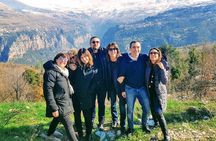
No expiration date
Easy refund
Free exchange
Easy booking
Guided Small-Group Tour to Baalbek, Cedars & Qozhaya with Lunch
$150
This is an experience gift voucher. The recipient will book the experience after
they redeem the gift voucher.
Overview
Save time, and combine the natural beauty and History in one day tour from Beirut. Enjoy the green sceneries on your way to Bcharre through the Holy Valley of Qadisha with a short stop at Kozhaya Monastery. Visit the Cedars of God forest, take some pictures, and head after to Baalback.
After lunch, Visit Baalbek, one of the most celebrated sanctuaries of the ancient world and home to the complex which includes two of the largest and grandest Roman temple ever built.
After lunch, Visit Baalbek, one of the most celebrated sanctuaries of the ancient world and home to the complex which includes two of the largest and grandest Roman temple ever built.
—
Guided Small-Group Tour to Baalbek, Cedars & Qozhaya with Lunch
Pickup included
Pickup included
Tour guide
Language: English
Human tour guide
- Professional, knowledgeable guides
- Air-conditioned vehicle
- Small group sizes
- Hotel pick up and Drop off
- Taste real Lebanon with a fresh, authentic lunch included.
- Entry / Admissions to Historical Sites
- Tour Leader
- Comfortable transportation
- Gratuities
- Qadisha valley is one of the most important settlement sites of the first Christian monasteries in the world, and its monasteries, many of which of great age, are set in an extraordinarily rugged landscape. The Qadisha Valley comprises all the caves, monasteries and cultivated terraces that are associated with the activities from a very early phase of Christianity. (pass by)
- Bcharre is the town of the only remaining and preserved original Cedars of God, and is the birthplace of the famous poet, painter and sculptor Khalil Jubran who now has a museum in the town to honor him. Moreover, Bcharre is home to the oldest skiing area, the Cedars Ski Resort and to Lebanon’s first ski lift, built in 1953. Bcharre is sometimes called "the city of churches" as it houses some 37 churches. (pass by)
-
The Cedars of GodThe Forest of the Cedars of God with its 375 trees, is the last remains of antique forests and one of the rare sites where the Cedars still grows. It was highly prized in ancient times and was one of the most valued construction materials of great religious buildings and cited 103 times in the Bible. The Cedar is the symbol of the country, its pride, and features prominently on the Lebanese flag.
-
Deir QozhayaThe Monastery of Saint Anthony the Great is situated at a height of 950 meters above sea level in the celebrated Valley of Qozhaya. The pine trees and oak trees cover the great hills surrounding it. Fruit trees of every description grow all along the valley, which extends into the Valley of Qannubin to form the great Qadisha Valley, thus bearing witness to the history of eremitic life and the quest for holiness in Lebanon. Historians and scholars suppose that this Monastery was first built and began to be occupied by hermits at the beginning of the fourth century. It was several times looted, set on fire and razed to the ground, but there still remain vestiges dating back to the seventh century.
-
Baalbek, is home to the Baalbek temple complex which includes two of the largest and grandest Roman temple ruins: the Temple of Bacchus and the Temple of Jupiter. It was inscribed in 1984 as an UNESCO World Heritage site. This Phoenician city, where a triad of deities was worshipped, was known as Heliopolis during the Hellenistic period. It retained its religious function during Roman times, when the sanctuary of the Heliopolitan Jupiter attracted thousands of pilgrims. Baalbek, with its colossal structures, is one of the finest examples of Imperial Roman architecture at its apogee.
-
Temples of BaalbekThe complex of temples at Baalbek is located at the foot of the south-west slope of Anti-Lebanon, bordering the fertile plain of the Bekaa at an altitude of 1150 m. The city of Baalbek reached its apogee during Roman times. Its colossal constructions built over a period of more than two centuries, make it one of the most famous sanctuaries of the Roman world and a model of Imperial Roman architecture. Pilgrims thronged to the sanctuary to venerate the three deities, known under the name of the Romanized Triad of Heliopolis, an essentially Phoenician cult (Jupiter, Venus and Bacchus).
- The Mosque of sayeda Khawla in Baalbek, Lebanon is erected on the site where Sayyida Khawla, the daughter of Imam al-Hussein, the grandson of the Prophet Muhammad, is believed to have been buried. People of Baalbek believe that when the caravan of captives of Karbala passed Baalbek, The daughter of Imam al-Hussein, called Khawla passed away and was buried there. (pass by)
-
The Stone of the Pregnant Woman is a worked Roman monolith in Baalbek, Lebanon. Together with another ancient stone block nearby, it is among the largest monoliths ever quarried. The two building blocks were presumably intended for the nearby Roman temple complex, and are characterized by a monolithic gigantism that was unparalleled in antiquity.
How it works?
01
—
You choose from 10,000+ experience gifts
02
—
We deliver the eVoucher or the Physical box to the recipient
03
—
Recipient books the experience and creates unforgettable memories!
Guided Small-Group Tour to Baalbek, Cedars & Qozhaya with Lunch
$150
This is an experience gift voucher. The recipient will book the experience after
they redeem the gift voucher.
How it works?
01
—
You choose from 10,000+ experience gifts
02
—
We deliver the eVoucher or the Physical box to the recipient
03
—
Recipient books the experience and creates unforgettable memories!




